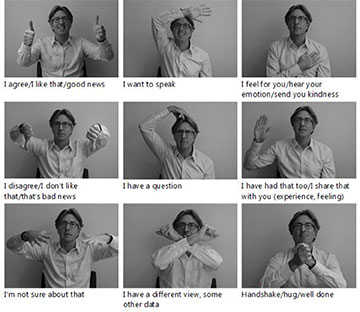Paul Hills demonstrating some of his video meeting signals. [Image: Paul Hills / University of Exeter] [Enlarge image]
Many of us are spending more time online than ever, and we’ve all felt that strange sense of weariness and isolation that comes from long hours staring at boxes on video calls—including the one containing your own face. Now researchers in the United Kingdom have an idea for stemming some of the torture: A few well-placed waves of the hand (PLOS One, doi: 10.1371/journal.pone.0270399).
Tired of video
Why does videoconferencing, which would appear to closely mimic face-to-face interaction, sometimes leave people exhausted and unengaged? According to the researchers, one possible explanation is that it lacks the nuances of in-person conversation that build rapport and facilitate natural exchange.
“Because you can’t make eye contact or pick up on subtle nods, gestures and murmurs of agreement or dissent in video conferences, it can be hard to know if people are engaged with what you’re saying,” explains Daniel Richardson, professor in the department of experimental psychology at University College London (UCL).
In an effort to replicate some of these lost subtleties, several platforms, including Zoom and Microsoft Teams, have put in response buttons or emojis that allow users to add another layer to their conversations. However, the researchers of the new work have instead turned to a more basic mode of communication: physical gestures.
A show of hands
Inspired by the hand signals used by lifeguards, UCL researcher and management consultant Paul Hills designed a system of simple gestures to employ during video conferences. The movements are intended to be easily remembered, adapted and used; for example, a wave to attract attention or a thumbs up for approval. Unlike in-person backchannel communication behaviors, such as small nods or raised eyebrows, the gestures are visible even in a small video chat window.
The researchers conducted two studies to test the effects of the gestures on video conference participants. In the first, the team provided training in their signal system to undergraduate UCL students who regularly had online seminar group meetings. They surveyed groups who used the gestures and control groups, and they found that the trained groups had a better personal experience, felt closer to their group, interacted better and felt they learned more.
In the second study, they tested three groups of people who did not know each other and were not students. The first was a control group, the second received training in the gesture system and the third were trained to use emojis during video meetings rather than hand signals. The results replicated those of the first study and also showed that use of emojis did not have the same positive effect as use of hand gestures.
The future of work
Through his company Konektis, Hills has successfully introduced the signal system to a number of organizations, including AstraZeneca and the Cornwall Chamber of Commerce. The researchers note that, although the positive results of their experiments were clear, the exact reasons behind the user benefits are not yet known and will be the subject of further research.
“Remote and hybrid work have huge potentials for making the workplace healthier, more inclusive and environmentally sustainable, but we need new ways of working to make this a success stories,” said co-author Matt Gobel, University of Exeter, UK. “Our study shows that using hand signals during videoconferencing is one way to do so.”

